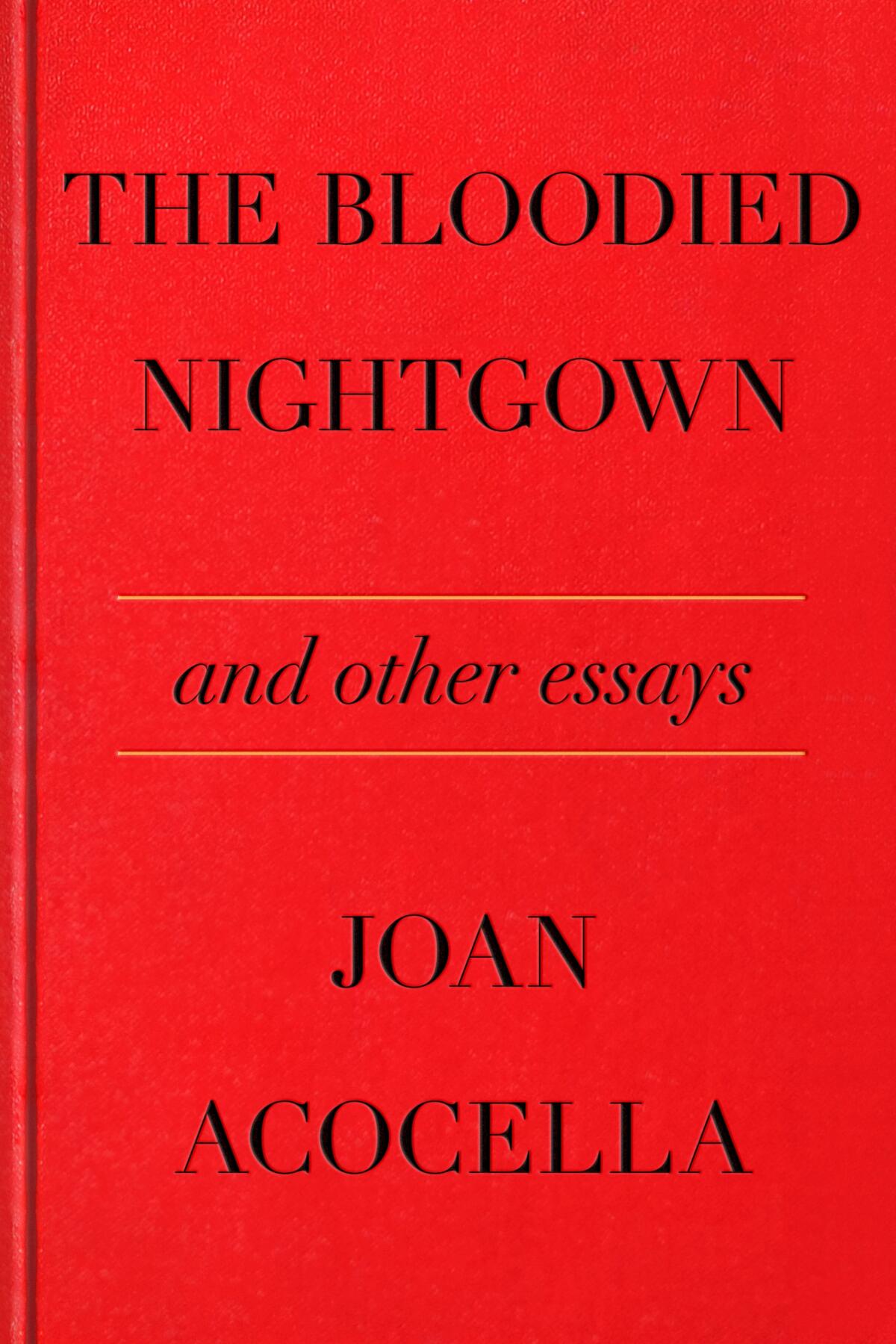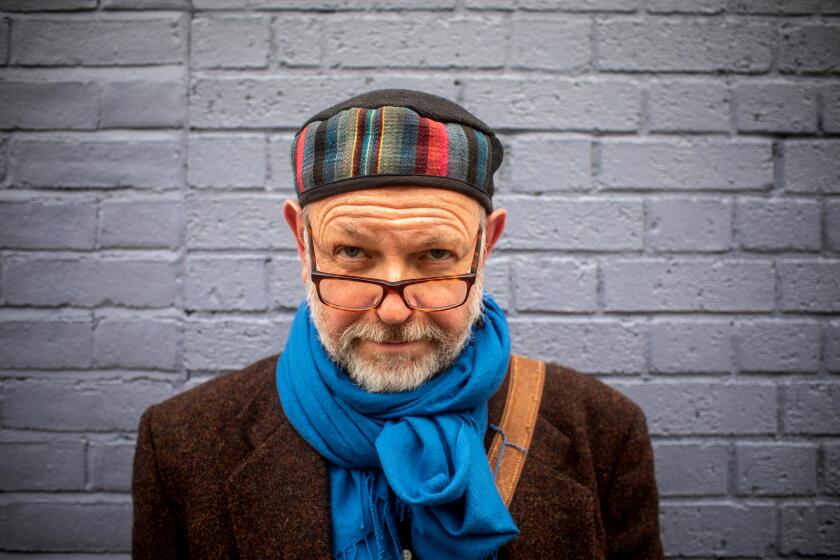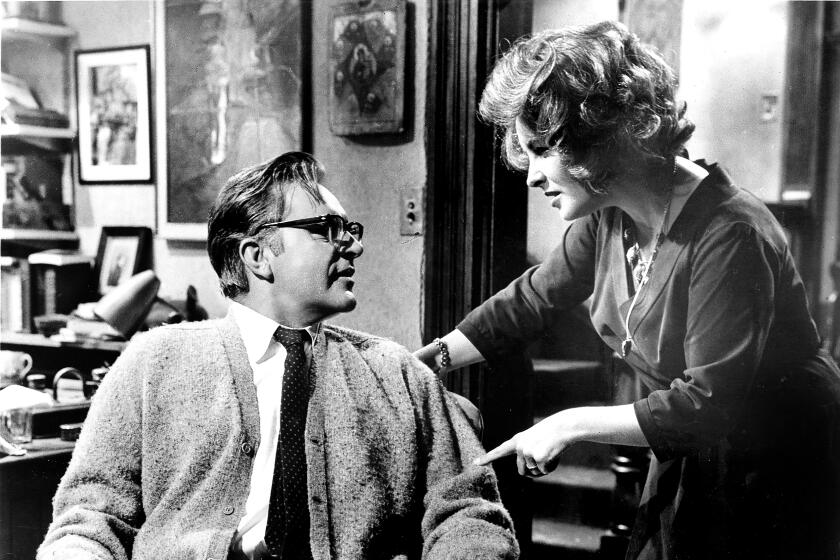‘The Bloodied Nightgown’ is a monument to Joan Acocella’s savage wit and unsentimental generosity

- Share via
Book Review
The Bloodied Nightgown and Other Essays
By Joan Acocella
Farrar, Straus and Giroux, 368 pages, $35
If you buy books linked on our site, The Times may earn a commission from Bookshop.org, whose fees support independent bookstores.
“I do think I know a hot dog from a real artist,” Joan Acocella observed modestly last year. Few would disagree. Watching her tell them apart, with an occasional blast of her savage wit, was a treat for readers for four decades. Sadly, the publication of her new collection, “The Bloodied Nightgown and Other Essays,” comes just weeks after her death Jan. 7 at age 78. Bringing together some of her smartest and most entertaining pieces on literature and language published between 2007 and 2021, the volume must now serve as a makeshift monument to Acocella’s career.
Many knew her best for her dance writing — she was the New Yorker’s dance critic for more than 20 years — but “The Bloodied Nightgown” is set offstage, in the library. Acocella was a cultural omnivore, and the menu here is correspondingly eclectic: Dracula, dictionaries, dirty words; Marilynne Robinson, Richard Pryor, Elena Ferrante; Gilgamesh, Beowulf, “Little Women.” The book’s 24 pieces offer not just an inventory of Acocella’s interests but also shining examples of what made her such a pleasure to read.
Calvin Trillin’s new collection of stories, ‘The Lede: Dispatches From a Life in the Press,’ reminds us not just of his brilliant plying of the trade but also of what the trade once was.
I spoke with half a dozen people who knew and worked with Acocella to get a sense of how she approached the art of criticism and her development as a writer. They remembered a warm, gossipy, hard-working, impatient, gregarious, kind woman who told jokes, took her friends to dance shows, knew her own mind and remained loyal — to the end — to the fax machine.
She first found her people —“people without tans, people who went to flute concerts,” as she described them — at Berkeley, in her native California. While studying there, she spent a junior year in Padua. (Her work would later feature many Italian artists, including, in “The Bloodied Nightgown,” Ferrante, Natalia Ginzburg and Gianni Rodari.) In her 20s, she married and moved to the East Coast; in her 30s, she got a PhD in comparative literature. The doctorate proved invaluable training, though not for a life in academia.
“It would have been hard for me,” Acocella once said, “to navigate the culture wars in the university.” This statement in part reflects, perhaps, her intolerance of intellectual dogmatism. For her, it was essential to keep the artwork itself unclouded by ideological notions, firmly in the crosshairs — this belief is at the heart of her monograph on “Willa Cather and the Politics of Criticism.” Writing about the Book of Job in “The Bloodied Nightgown,” she chides author Mark Larrimore for the way he humors the battier interpretations that writers through the ages have foisted on Job: “Eventually it comes to seem anti-intellectual. At times, Larrimore sounds like a kindly Unitarian minister, or like Mister Rogers.”

A touch as light as hers belies the sleepless nights it took to acquire. Acocella’s exhaustiveness was all behind the scenes. Compactness is a hallmark of her writing, made possible by both hard graft and her gifts for exposition and exegesis, which enabled her to digest and repackage huge quantities of material. For “Queen of Crime,” she read all 66 of Agatha Christie’s detective novels (successfully guessing just two of the culprits). Indeed, she often read dozens of books for a single piece, later couriering a trunkful of volumes, still carrying a whiff of cigarette smoke, to the New Yorker’s fact-checking department. While researching her (sadly abandoned) book about Baryshnikov, she asked the New York Public Library for the Performing Arts, where his papers are housed, if it could ship the entire archive to her apartment. The request, understandably, was denied.
All this toil gave Acocella the ability and license to distill and make big judgments even within the restrictive word count of a review or magazine piece. “[He] was seventy when Out of Sight was published,” she wrote of Elmore Leonard. “He wrote thirteen more novels. All of them were overpraised.” If this seems harsh, she goes on: “Not all of Leonard’s books are on [the level of Out of Sight], but five or six of them are, plus parts of many others. That’s a lot.” It’s the last line of the piece and characteristic of her concise, unsentimental generosity.
With ‘Cahokia Jazz,’ Francis Spufford tells an intricate, suspenseful and moving story that rises from the mists of America’s prehistory and morphs into an alternate version of America’s story.
She was good at endings. Especially poignant in light of her own are the moments when she uses a subject’s death as a moment to distill an essential truth — sometimes lovely, sometimes tragic — about their life. Of Bela Lugosi, following his star-making turn in “Dracula,” she wrote: “Thereafter, this ambitious Hungarian actor had a hard time getting non-monstrous roles. He spent many years as a drug addict. He was buried in his Dracula cloak.” Twenty-five years in three sentences, the pathos all in the economy. When Francis Bacon, an artist who (his name notwithstanding) had a lifelong fascination with viscera and butchery, died at age 82, she remarked with more tenderness than may be immediately apparent: “He was meat at last.”
For Acocella, artists’ biographies are often inseparable from their work. “I could not do without the life,” she admits in the introduction to “The Bloodied Nightgown.” This may stem in part from her early career success as an editor at Random House, where she wrote, with two co-authors, a textbook on abnormal psychology. (The book went through so many updated editions that she was able to use the proceeds from its revisions to support early excursions into the less lucrative field of dance criticism.)
‘Cocktails With George and Martha’ examines what it means to live as husband and wife, and how ‘Who’s Afraid of Virginia Woolf?’ kicked down staid cultural depictions of marriage.
Psychology may not have been her chosen subject but Acocella used what she learned. It surely complemented her interest in Vaslav Nijinsky, whose dance career was cut short by a schizophrenia diagnosis (and whose unexpurgated letters she edited for publication). It may also have informed the psychological attention she paid to her subjects. Writing about Louisa May Alcott’s later work, for instance, she draws a clear line between Alcott’s ill health and the exhaustion she perceives in the text. “Jo’s Boys,” she wrote, “is actually a chore to read. Alcott tries to whip up some excitement — there is a shipwreck, an explosion in a mine — but you can sense how bored she is, and how much she wants to go upstairs and take a nap.”
The biographical material in “The Bloodied Nightgown” serves not just as context but also as information of interest in itself. I didn’t know that, late in life, the Brothers Grimm worked on definitions from A to F for a major German dictionary. Nor did I know very much about J. R. Ackerley’s relationship with his dog Queenie, though what I now know can scarcely be printed in a family publication. Acocella’s gift for tart summary lent vividness even to an artist’s resume: Of Graham Greene’s approach to his freelancing, which encompassed both magazine pieces and intelligence-gathering for MI6, she wrote: “Basically, anytime an organization needed someone to go, expenses paid, to a country that had crocodiles, he was interested.”
Acocella’s work was usually in the service of art she loved and wanted to share. “Thrill” and its cognates occur not infrequently. You can tell she’s having fun. (On wicked stepmothers: “These women at least have some gumption, unlike the little Barbies they are trying to eliminate.”) The terrific piece on swearing, mostly unquotable here, is a delicious exercise in restraint and targeted release. As she says, “When you drop your grocery bag into a puddle or close the window on your finger, ‘geez Louise’ is not going to help you much.”
At one point, Acocella considered calling this final collection “Book Reports” — a token, perhaps, of her no-nonsense professionalism. But this wouldn’t have adequately described the gloves-off character — the glee! — with which she wrote. “The Bloodied Nightgown” shows that with age she only got funnier, pithier and more pungent. Long may she be read.
Charles Arrowsmith is based in New York and writes about books, films and music.
More to Read
A cure for the common opinion
Get thought-provoking perspectives with our weekly newsletter.
You may occasionally receive promotional content from the Los Angeles Times.












